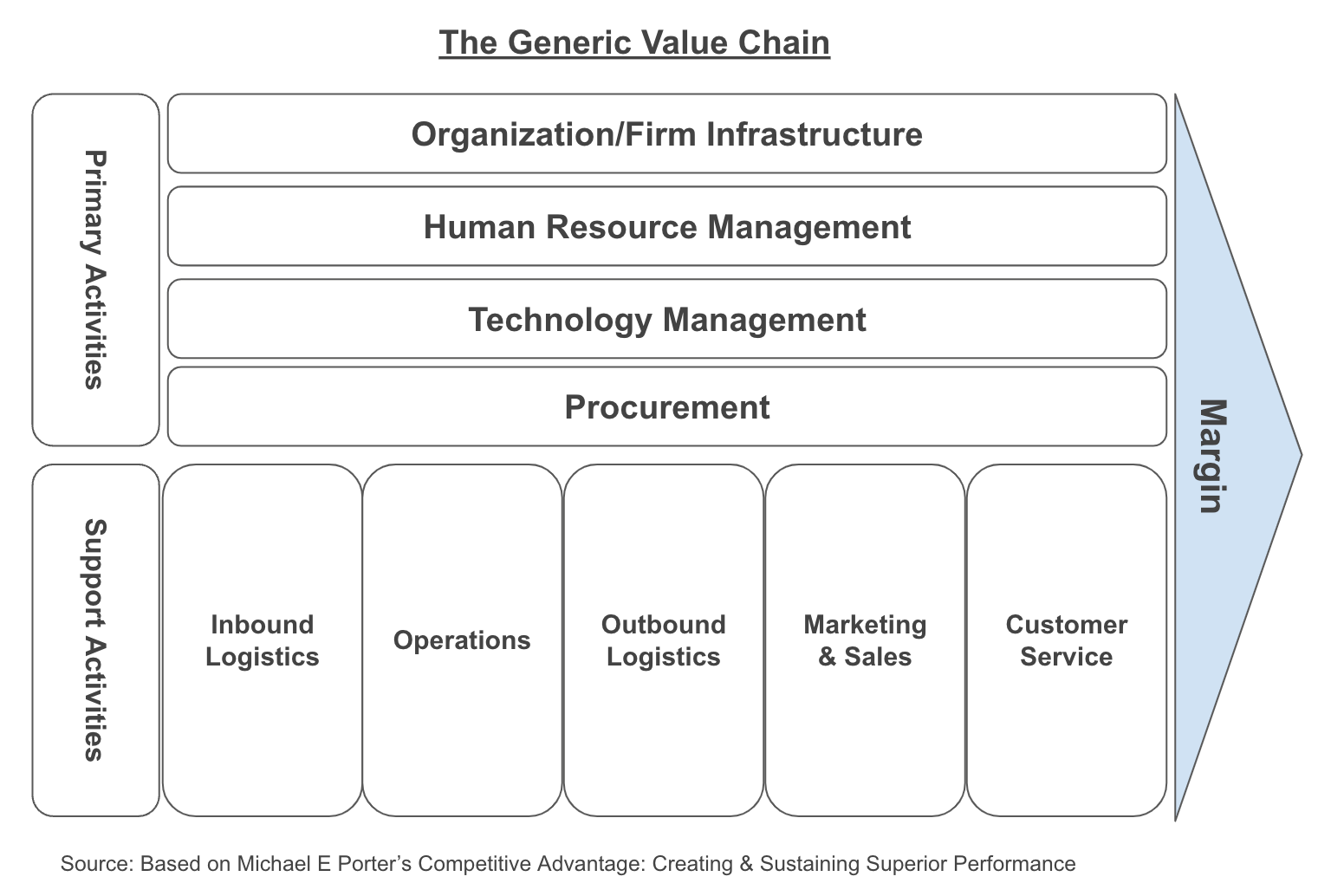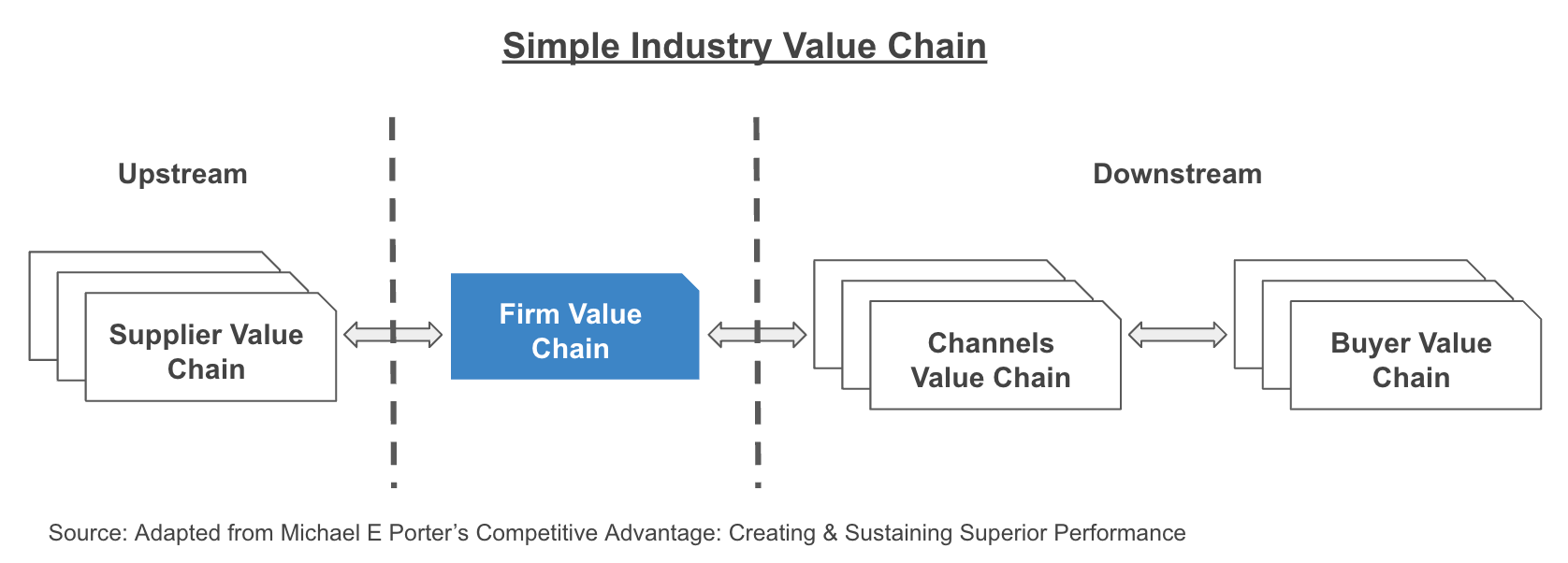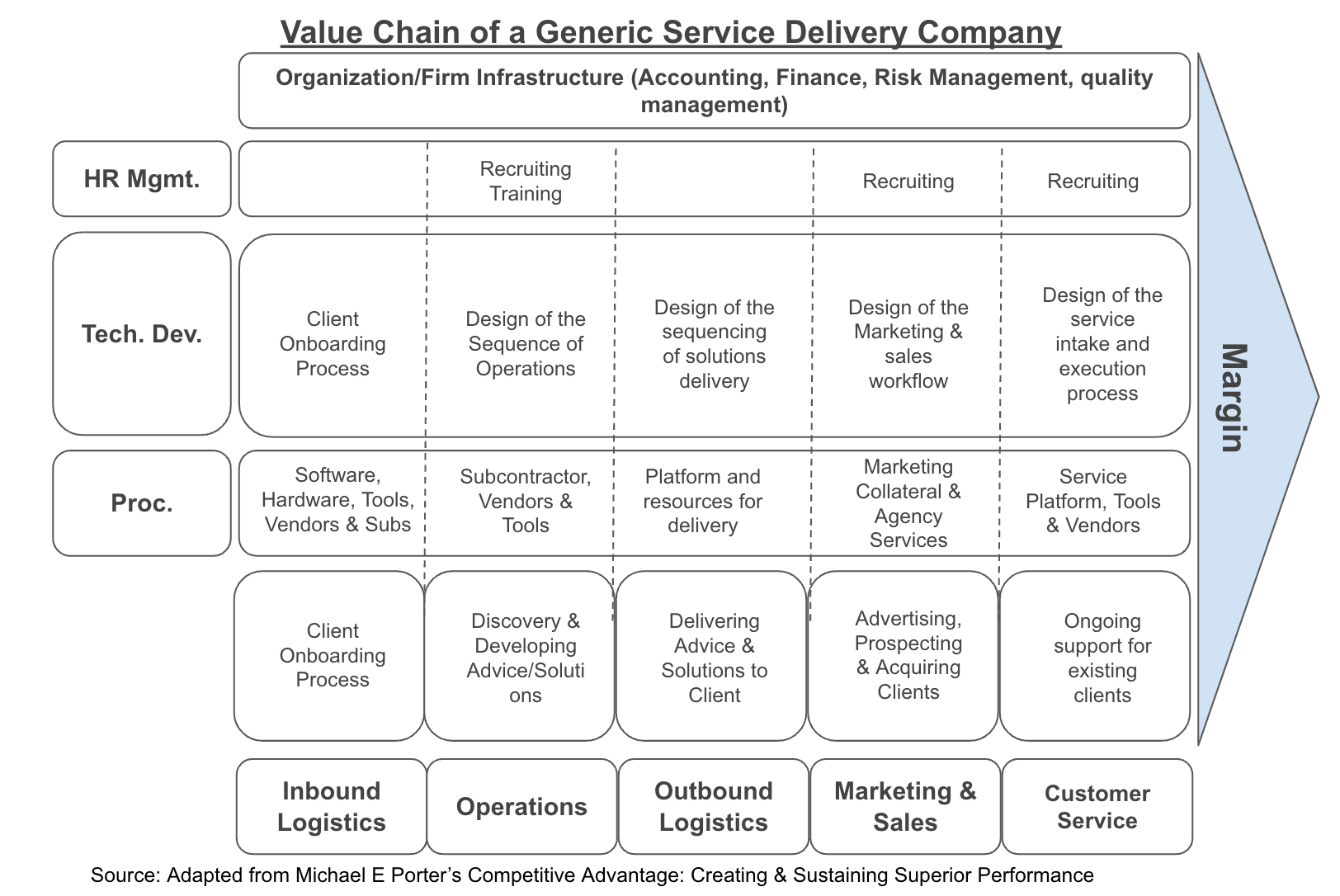How to use Porter’s value chain model as a COO to generate customer value and increase profits.
Introduction
The modern business landscape is complex and Chief Operating Officers (COOs) play a critical role in ensuring their organizations operate effectively and efficiently. One of their core responsibilities, which is often overlooked is understanding and optimizing their organization’s value chain. The value chain is a system that encompasses all the activities involved in producing and delivering a product or service, as well as the interconnections between these activities. By gaining a very clear understanding of all the activities and steps that create the value chain, COOs can perform value chain analysis to identify areas of underperformance, analyze the reasons behind them, and implement strategies to sustain operational excellence and competitive advantage.
What is the value chain concept?
The value chain concept, was first introduced by Michael E. Porter in his book “Competitive Advantage.” It explains how the internal systems and operations (primary and secondary activities) of an organization significantly influences and impacts a company’s competitive strategy, its overall competitive advantage, and its value proposition to customers and buyers.
The value Chain of an organization
The value chain of an organization is the sequence of activities that a company performs to design, produce, market, deliver, and support its products or services in a way that differentiates it from competitors to create competitive advantage and increase profit margins.
The value chain of one organization is often part of a larger industry value system that includes upstream and downstream value chains. The value chains in the industry value system mutually influence one another other, and to be sustainable longterm, must seamlessly integrate and adapt to changes (economic, political, climate, and etc.) overtime.

The value chain of a supplier
A supplier provides resources and inputs necessary for the recipient organization to produce it’s output which may come in the form of a service or a product. Suppliers in a value system are positioned upstream of the organization and the upstream activities are represented by the supplier value chain.
The value chain of a customer or buyer
On the other hand, the downstream activities are reflected in the buyer’s value chain, which involves the processes and activities of channels, customers or clients who transmit/transfer or use or consume the organization’s products or services.

What are primary and support activities?
The value chain is composed of primary activities and support activities. Each type plays a crucial role in the system with primary activities often focused on delivering value to the customer and support activities often focused on supporting the organizations’s overall operations, to include helping primary activities perform effectively.
Primary activities
The common primary activities in a value chain are:
- Inbound Logistics: Managing incoming raw materials, their storage, and their distribution to the various stages of production. This is the front-end of inventory management.
- Operations: This is multifaceted and covers the actual transformation of resources and raw materials into the final product or service. It can includes activities such as manufacturing, assembly, packaging, and quality control.
- Outbound Logistics: Outbound logistics deals with the storage, transportation, and distribution of the finished product to customers or intermediaries. This is the tail-end of inventory management.
- Marketing and Sales: This may be the easiest to explain because it interacts with the consumer more frequently as it focuses on promoting the product or service, identifying customers need, generating sales, and building customer relationships.
- Service: The service activity involves providing after-sales support, customer service, maintenance, and other activities aimed at enhancing customer satisfaction.
Support activities
Common support activities in a value chain are:
- Procurement: Procurement is the process for acquiring inputs, such as raw materials, equipment, and supplies, needed for the value chain. These activities can include vendor selection, negotiation, and contract management.
- Technology Development: Technology development, not to be confused with information technology or software development, encompasses activities aimed at improving the overall operations process of the organization. It can include research and development, process improvement, innovation initiatives, and the adoption of new technologies.
- Human Resources Management: Human resources management focuses on the recruitment, hiring, training, development, and compensation of personnel. A key role for this activity is to define employee development plans that align with the needs of the value chain.
- Firm Infrastructure: Firm infrastructure represents the support functions necessary to enable the entire value chain to operate smoothly. It includes general management, accounting and finance, risk management, legal compliance, and quality management. Firm infrastructure provides the necessary organizational structure, policies, and systems to support the value chain activities and potentially create efficiencies.

How are the activities in a value chain linked?
The value chain is not a series of isolated tasks but rather a system of interrelated activities. One of the key aspects of the value chain is the presence of linkages and interdependencies between different activities and outcomes. Some may argue that this might be the most important aspect of the value chain that a COO must understand because managing and optimizing these linkages is critical for creating competitive advantage and operational efficiency.
Benefits of linkages
Identifying and managing linkages within the value chain can lead to cost reductions, process improvements, and enhanced differentiation. It allows COOs to identify areas where integration, collaboration, or optimization can yield significant benefits.
Example of linkages
For example, focusing on producing a high-quality product can reduce post-sale service costs and enhance customer satisfaction, leading to repeat purchases and positive word-of-mouth. The linkage here is the direct effect on post-sale service cost by producing high-quality products. To produce high quality products the organization could purchase high quality material, improve quality control practices or both.
Similarly, effective coordination between operations and outbound logistics can improve on-time delivery, reduce inventory carrying costs, and enhance customer experience. The linkage here is by producing material after an order is confirmed the organization can reduce the inventory cost for finished goods, and can also improve customer experience because the customer may be able to customize the order, within reason.
Linkages beyond the organization
Linkages also extend beyond the organization’s value chain to include the interactions in the industry chain between the supplier’s value chain upstream, and the buyer’s value chain downstream. The way a supplier performs its activities can have a direct impact on how and what the organization decides to procure or purchase from the supplier. Similarly, the organization’s product or service represents a purchased input for the buyer’s value chain.
It is also important for the organization to understand the value chain of the buyer (i.e. is the buyer a business or an individual/household?). Both business/organizational buyers and individual/household buyers will inform the competitive position the organization pursues, therefore understanding the buyer’s value chain (or needs) is important. This directly relates to marketing and sales activities.
What role does value chain play in competitive advantage?
An organization’s competitive advantage lies in the value it creates for the buyer, which can lower the buyer’s costs or provide unique benefits that differentiate the organization’s products or services from competitors. Value creation is heavily influenced, if not fully influenced by the internal value chain of the organization.
By analyzing and optimizing the value chain, COOs can identify areas where their organizations can improve its operations, reduce costs, enhance product quality, streamline processes, and ultimately deliver greater value to customers. This, in turn, strengthens the organization’s competitive advantage.
Strategic Decisions Based on the Value Chain Analysis
Understanding the value chain also allows COOs to make informed strategic decisions to align with the company goals and desired competitive advantage. A common decision is the decision to outsource or vertically integrate certain activities. Outsourcing involves contracting external vendors or suppliers to perform specific activities within the value chain, while vertical integration involves bringing those activities in-house.
COOs can evaluate whether a particular activity is a core competency of the organization that should be performed in-house or whether it can be performed more efficiently and effectively by a specialized external vendor. If outsourcing can lead to saving money, accessing expertise, or other strategic advantages, it may be the better option. On the other hand, if integrating a specific activity within the value chain can result in better quality control, or faster delivery times, vertical integration may be the better consideration.
Conclusion
The Value Chain, commonly known as Porter’s value chain was first introduced by Michael E. Porter in his book “Competitive Advantage.” It is a fundamental framework for Chief Operating Officers (COOs) to understand and ensure their organizations are operating as effectively as possible. It provides a full view of the activities involved in producing and delivering a product or service, as well as the interdependencies and linkages between these activities. It can also help COOs identify opportunities of improvement within the firm to ultimately deliver greater value to customers.
The value chain is closely tied to an organization’s competitive advantage and overall competitive strategy because it helps COOs determine how the firm differentiates itself and adds value to the buyer’s chain. Understanding the value chain also allows COOs to make strategic decisions regarding operating efficiencies around outsourcing or vertical integration of activities.
In today’s complex business landscape, COOs who grasp the intricacies of the value chain and leverage its insights have a high probability of running their organizations as effectively as possible while enhancing the overall competitiveness of the organization. By performing frequent value chain analysis COOs can position their organizations for sustained success.

